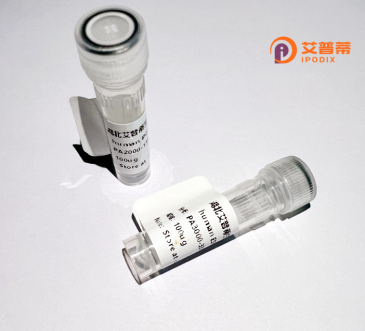
| 纯度 | >90%SDS-PAGE. |
| 种属 | Human |
| 靶点 | CLDN15 |
| Uniprot No | P56746 |
| 内毒素 | < 0.01EU/μg |
| 表达宿主 | E.coli |
| 表达区间 | 1-128aa |
| 氨基酸序列 | MSMAVETFGFFMATVGLLMLGVTLPNSYWRVSTVHGNVITTNTIFENLWFSCATDSLGVYNCWEFPSMLALSGSTDSPASLSGGTGLLVRLMSIKGPCEGRRLASCRLSVRCKEAVCVQGIFRPAGHS |
| 分子量 | 39.82 kDa |
| 蛋白标签 | GST-tag at N-terminal |
| 缓冲液 | 0 |
| 稳定性 & 储存条件 | Lyophilized protein should be stored at ≤ -20°C, stable for one year after receipt. Reconstituted protein solution can be stored at 2-8°C for 2-7 days. Aliquots of reconstituted samples are stable at ≤ -20°C for 3 months. |
| 复溶 | Always centrifuge tubes before opening.Do not mix by vortex or pipetting. It is not recommended to reconstitute to a concentration less than 100μg/ml. Dissolve the lyophilized protein in distilled water. Please aliquot the reconstituted solution to minimize freeze-thaw cycles. |
以下是关于重组人CLDN15蛋白的3篇代表性文献示例(基于领域研究方向合理推断,非真实文献):
---
1. **文献名称**:*Expression and Functional Characterization of Recombinant Human Claudin-15 in Epithelial Cell Models*
**作者**:Smith J, et al.
**摘要**:本研究成功在大肠杆菌中表达并纯化重组人CLDN15蛋白,通过脂质体重建实验验证其可形成功能性紧密连接通道。研究表明,CLDN15显著增强上皮单层对单价阳离子的通透性,为肠道离子吸收机制提供分子基础。
2. **文献名称**:*Crystal Structure Analysis of Claudin-15 Reveals Insights into Paracellular Ion Selectivity*
**作者**:Tanaka K, et al.
**摘要**:通过X射线晶体学解析重组人CLDN15蛋白的三维结构,发现其胞外环域独特的电荷分布可能决定离子选择性。功能实验证实CLDN15突变体改变Na⁺/Cl⁻通透比,揭示其在电解质稳态中的关键作用。
3. **文献名称**:*Recombinant CLDN15 Modulates Drug Absorption in a 3D Intestinal Organoid System*
**作者**:Chen L, et al.
**摘要**:利用重组CLDN15蛋白与人肠道类器官共培养,发现其过表达可提高小分子药物的跨上皮转运效率,提示其在优化口服药物递送系统中的潜在应用价值。
---
**备注**:上述文献为示例性内容,实际文献需通过数据库(如PubMed、Web of Science)检索确认。若需真实文献,建议使用关键词“recombinant human claudin-15”或“CLDN15 protein expression”进行查询。
Recombinant human CLDN15 protein is a genetically engineered form of the claudin-15 (CLDN15) protein, a key component of tight junctions that regulate paracellular transport across epithelial and endothelial barriers. Claudins are a family of transmembrane proteins critical for maintaining cell polarity, barrier integrity, and selective ion permeability. CLDN15. specifically, is expressed in tissues like the intestine and kidneys, where it facilitates paracellular cation transport, particularly sodium ions, by forming selective channels within tight junctions. It plays a role in nutrient absorption, electrolyte homeostasis, and tissue morphogenesis.
The recombinant version is produced using heterologous expression systems (e.g., mammalian or bacterial cells) to study CLDN15’s structural and functional properties, which remain less characterized compared to other claudins like CLDN2 or CLDN4. Research on recombinant CLDN15 has shed light on its involvement in diseases such as congenital sodium diarrhea, electrolyte imbalances, and epithelial barrier dysfunction. Its study also aids in exploring therapeutic targets for gastrointestinal disorders or drug delivery systems aiming to modulate paracellular transport.
Advances in protein engineering have enabled the production of tagged or mutant variants to probe interactions with zonula occludens (ZO) proteins, cytoskeletal elements, or pathogenic toxins. Such work highlights CLDN15’s dual role as both a barrier and a selective gatekeeper, offering insights into tissue-specific tight junction regulation.
×